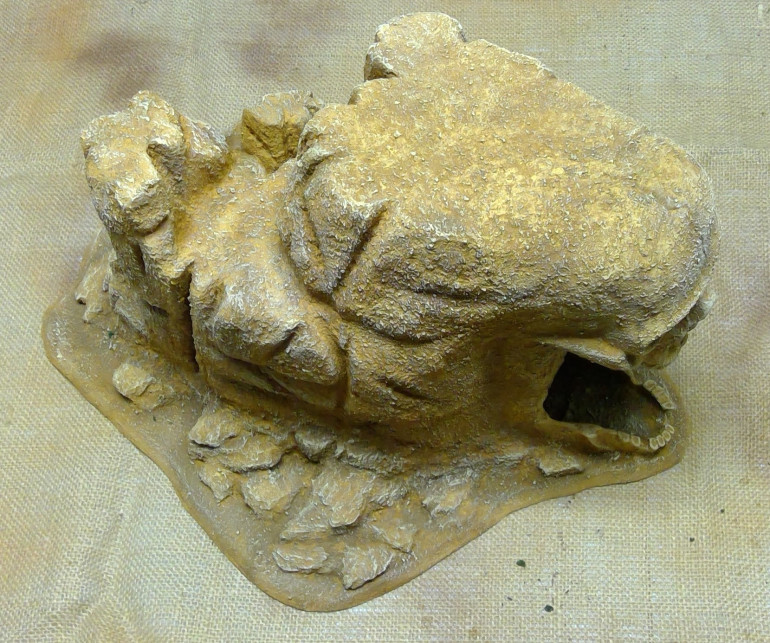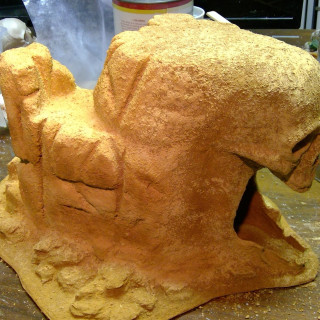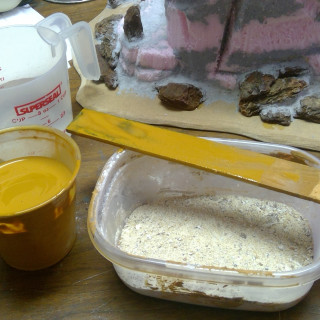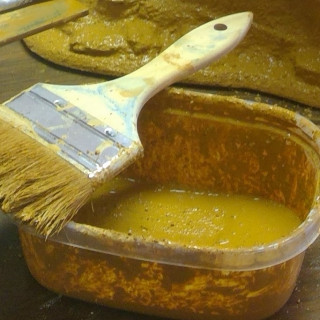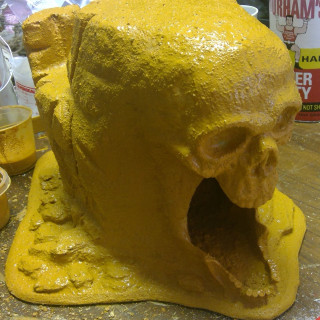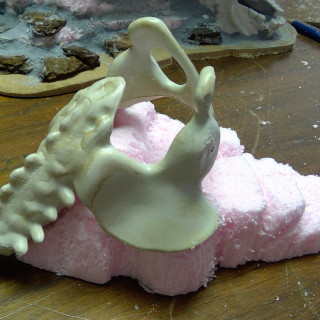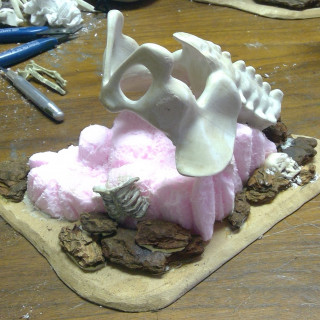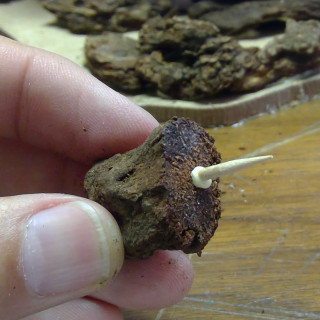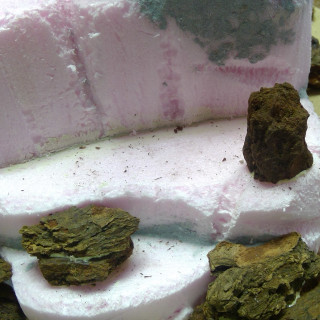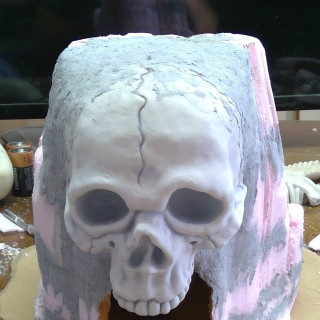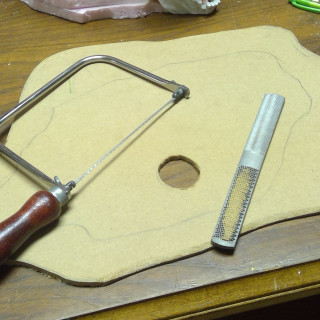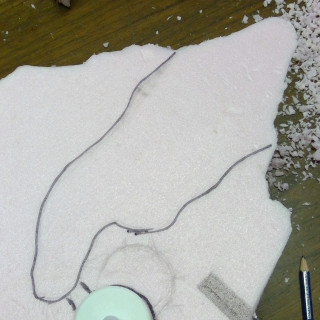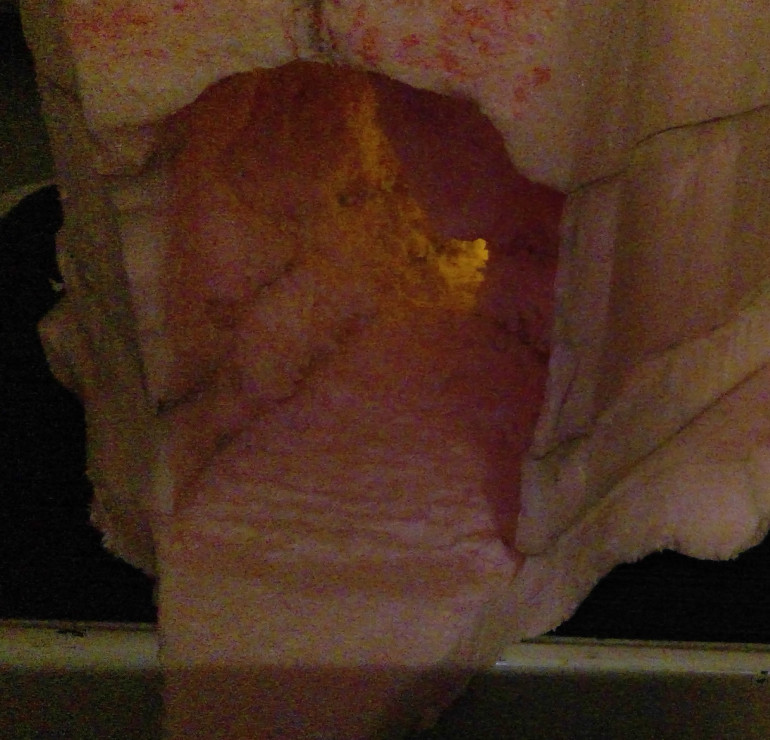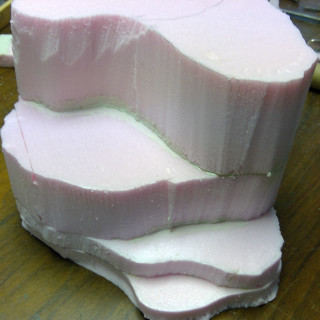
The End is Nigh: Deadlands
Recommendations: 354
About the Project
For my “The End is Nigh” terrain challenge entry, I will be producing a full-blown nightmare landscape, known as a Deadland, in the award winning, Weird West, Deadlands RPG setting, as well as the Great Rail Wars miniatures game and some board and living card games, by Pinnacle Entertainment Group, first published in 1996 and still going strong with it’s Reloaded version using their Savage Worlds engine. In the setting there are some evil spirits that are attempting to turn the world into a true Hell on Earth by causing more and more fear throughout the land which causes even the landscape to warp. The end goal is the world to become a Deadland at which time these spirits can freely walk the earth.
Related Game: Savage Worlds
Related Genre: Western
This Project is Active
Skull Cave Mesa Complete
The first piece of deadland is complete and the fear level has increased. I may still add a few “bushes” and or tufts around the rocks on the base.
Now that this nice large centerpiece is complete, it is time to get stuck in on more twisted landscape.
I may have to make a removable mine car track that can be placed into the cave opening. I can’t think of a better place to go mining for Ghost Rock.
Shadows and Highlights
I mixed up a darker brown to use in the recesses, as well as dabbed randomly about, to give more visual interest. For this I took the same latex paint in the mix above and added some burnt umber acrylic hobby paint.
As I said, I primarily added this shade to the cracks, around and under the “rocks”, inside the cave itself, and in the recesses of the skull. I also did some dry brush dabbing around the entire mesa to give it a more natural look.
The highlights were accomplished by simply dry brushing two lighter colors all over the model. The first of these two drybrush layers was done quite un-uniformly as you want it to look mottled and natural. The second, much lighter cream color, was first focused on highlighting the top surfaces, edges, and “rocks”, then lightly drybrushed over most of the model in varying thicknesses, again for visual interest. If you do it too evenly over the whole model it will look flat and unrealistic.
Alternate Methods for a Durable, Textured, Base Coat
There are a few other methods of obtaining a robust textured base coat on foam.
A quick and easy way is to simply slop on a heavy layer of the flat latex house paint and while it is still wet throw/dump sand all over the model. Once it has dried, gently brush away the excess sand and paint a second coat of the base color to seal/glue the sand solidly in place.
If you would prefer a more flexible, less likely to chip, surface I would suggest mixing sand and a bit of paint into Acrylic Medium (basically thick acrylic paint with no pigment). Woodland Scenics has a product for this, called Flex Paste (https://woodlandscenics.woodlandscenics.com/show/item/C1205), however I have found Liquitex Acrylic Medium to be much less expensive from stores like Hobby Lobby here in the states (plus those type stores always have a 40% coupon online). When set, the medium is quite flexible, and can still be painted.
There are also other types of plaster like substances you could use. One that I like as well as the Durham’s is All Purpose Foam Coat from Hot Wire Foam Factory. (https://hotwirefoamfactory.com/Foam-Coat-Foam-Glue-Foam/)
Thicken it up
Once it had dried I realized that I had made the mix a bit thin.
I wanted the model to be more robust, so I mixed up another, much thicker, batch and applied it only to the areas that had been bare foam. You can see those areas in these photos as they are much lighter in color due to there being more of the Durham’s putty in the mix. This actually ended up acting as a pre-highlight layer for the model, as well as giving those areas much more strength.
Slopping on Texture
Adding the base color and texture all in one go.
There are several ways to accomplish a durable, textured, base coat. For this project I opted for mixing sand into Durham’s Water Putty and adding paint to the water to give it color all the way through the putty/plaster should it ever chip. The paint I use for large terrain pieces is interior flat latex house paint that I have color matched at the hardware store. I buy it by the gallon and they last for a very long time. I actually had to replace the buckets for a couple of the colors due to the tops rusting, but the paint was still good.
This mix is then simply slopped on all over the model, making sure to get in into all the nooks and crannies. I did this with a large chip brush, as they are very inexpensive and disposable if the putty begins to harden before you can clean the brush. Once I had covered the entire mesa, I went back over it and cleaned up any large “puddles” of the mixture. I then left it to dry.
Increasing the Fear Factor
Time to warp more of the scenery.
While waiting for the last batch of CelluClay to dry on the skull cave, I took the opportunity to start on the next piece of terrain. I rough cut the foam with my coping saw and quickly shaped it using nothing more than the heavy rasp, test fitting the skeletal bit as I went. I also cleaned up the mold lines from the skeletal pelvis and backbone.
I then drilled a hole in the backbone to allow for pinning to the foam. The bone was then glued to the foam in the same manner as above with the skull. I also used a bit of the glue to fill a few holes in the plastic bones.
While that set up, I cut a base using the same MDF as above and beveled the edge with my Dremel tool. If you use this method yourself, please do so outdoors and wear a filter mask. It is not at all good to breath the dust from MDF.
I then mounted the foam to the base and added rocks like I did on the skull cave. I also added a few more skeletal bits among the rocks around the base. This will all be blended together with CelluClay as before.
Avoiding Club Fingers
A couple more tips on working with CelluClay.
This stuff is quite sticky and likes to clump up on your fingers, thus forming what I like to call “Club Fingers”, the same as dough will clump up on your fingers if you don’t add flour to your hands while working with it in the kitchen. In the case of CelluClay, simply keep your fingers moist. I keep a small cup of water nearby to dip my fingers, and tools, in while I work. It also helps when smoothing out and shaping the clay.
I’ll update with a photo of “club fingers” next time I work with the clay.
When mixing the CelluClay do so in a large ziplock bag, it will keep your hands clean. Also, if you mix up too much you can push the air out and zip it closed. You can then store the leftovers for a bit in the refrigerator and not waste it.
Blending it all Together
I once again mixed up a large batch of CelluClay to start blending in the lower jaw and the rocks, and to add some texture to the top surfaces of the mesa. At this time, I remembered that the CelluClay didn’t like to stick to the slick surface of the pink foam so I roughed it up a bit with a rasp in order to give it a surface to hold onto. You can see this in the areas circled in red in the first image below.
While blending in the lower jaw, I attempted to make it look as if the jawbone extended up to join the skull.
Rock On!
Once all that had time to set I added large “rocks”, in the form of pine bark nuggets, around the bottom of the mesa just like the others I already own. These stacks of “rocks” were mostly glued in place with wood glue.
For the one sort of standing on the second layer of the mesa, I decided to pin it with a toothpick to give it more support and strength.
It’s getting difficult to find the large pine bark chips/nuggets here in the states. They are used in gardens and landscaping. Years ago, you could get very large, three cubic foot, bags of large bark chips, like 4+ inch sized chips. That size bag would last most gamers, or even clubs, a lifetime. These days the nuggets in those bags are quite small. Also those bags hold moisture for ages, and are stored outdoors in most cases, and one would have to dry the nuggets in some way before using. That said, those large bags cost only about 3usd, so it might be worth the effort to pick through the bag and dry them in an oven on low. If you do that, please keep an eye on it as you wouldn’t want to burn down your home.
I got lucky. As I was shopping for the nuggets, I spotted some smaller bags of the things on a clearance table for only $1 each. While that is still considerably higher in price than the large bags these were all nice sized chips and were dry. I purchased six bags. That should last me through several projects.
Once all of this is set up I will come back once again with CelluClay to blend the jaw into the mesa as well as blending in the “rocks” and filling some of the gaps.
Basing
I glued the cave to the base using the same technique as gluing up the layers. I made sure the hole for the tea light lined up with the hole in the cave. I also glued the lower jaw in place.
Arrrrrrrrrggggggg
I write up a big entry, hit publish, and after several minutes of “spinning” nothing happens and the entry is gone. Last time that happened the site had logged me out without me knowing. Not so much this time.
Time to do it again. Perhaps in a couple smaller chunks.
The Shape of Things
While the CelluClay was drying I began to work in the details around the mesa. These take the form of slightly rounding the hard edges and adding cracks and gouges to give a more natural look and visual interest. The gouges were achieved in a variety of ways, for some I simply cut them in with a hobby knife, pencil and other pointy objects, but most were done with a heavy rasp, as was rounding the edges. I prefer the rasp, despite the mess it makes. I find that the details come more naturally and start to define themselves. To take out larger chunks, use the rasp as intended, by pushing. To have a bit more control you can pull the rasp in the “non-cutting” direction, this also creates less mess and gives a finer cut and smoother surface.
Once the layer of CelluClay had cured I could add one last layer to the area around the skull to make it blend more seamlessly into the mesa, thus making the shape more natural. I also filled gaps at this time as well.
I will add the final gouges/crags in the CelluClay once it is all mounted up, with the bottom jaw in place and blended in. Which is the next step.
The Ways of CelluClay
Having now redone the CelluClay sections, I can say that I most certainly used too much water. I have now reworked those areas, following the instructions a bit closer using warm water the help it mix and much less of it. I worked in a couple of layers, as opposed to one heavy one, to aid in the drying time.
I also worked some across the tops of the mesa to eliminate some of the boring flatness and started filling some of the gaps between the layers of foam. I found that the CelluClay does not like the smooth surface of the slick flat areas so I simply smeared some wood glue over, and slightly under, those areas. That said, it’s sticking fine to the cut or roughed up sections as well as the primed skull.
I will add a bit more CelluClay to make the transition from mesa to skull a bit more seamless and more “natural” looking. I will also be blending the bottom jaw into the mesa and up to the skull once it is all mounted to the base. I want the bottom jaw to appear as if the mesa has opened its giant mouth, not like the jaw fell to the ground.
Dry *@#% You....Dry!
Well, I’m now stuck waiting for the CelluClay to dry. It was my first time using it and I’m not sure if I added too much water or put it on too thick but it’s taking much longer to dry than I had expected. I think I’ll purchase some Sculptamold soon to compare the two.
If it’s not dry by morning I will dig out what is still wet and add more dry CelluClay to the mix and give it another shot.
This first bit of Deadlands only has about another day or so of work to be completed. If our family vacation had not been smack in the middle of the challenge, I would be done with this nice centerpiece and on to the other table fillers.
Still, this challenge was the motivation I needed to get in gear on this project. I plan to continue working on the Deadlands over the next couple weeks, then come back to it periodically, and will continue to post my progress.
Prepping the Base
I made a rough outline of the mesa, including the hole for the tea light, on a sheet of MDF. I then cut it out with a jigsaw. For the hole for the tea light I drilled a largish hole in the center and finished the cut with the jigsaw. I then lined up the mesa/cave on the base and traced around it so I have guidelines when it comes time to glue it down. I also redefined some of the edges and re-cut them with a coping saw (which is kinda like a wood saw version of the jewelers saw).
Now it is on to beveling the edges. I started with a rasp and once I have a decent bevel I will smooth it all out with a palm sander in the morning. It’s too late in the evening to run a power tool.
Mounting the Skull
The skull is now pinned in place with the skewers and glued with Liquid Nails: Project adhesive.
I have also started to fill the large gaps with the CelluClay. CelluClay is basically a fine paper-mache substance that you just add water to. It is sandable and paintable when dry. I will be adding more as the build goes on.
Pre-painting the Cave
As it is much easier to reach all the nooks and crannies of the cave without the skull in place I went ahead and gave it a good heavy coat of a mix of sand and the Durham’s Water Putty tinted with interior flat latex house paint (color matched to the ooooooold Citadel Snake Bite Leather). This will dry nice and hard, with a sandy, rocky texture already in place. I will do the same over the entire model before it’s over, at which time I will go into more detail on this method.
The color is a tad more orange than I’d like but I can take care of that with a heavy wash of another darker brown.
Deeper and More Interesting
While I have decided not to make the interior of this cave “playable”, by that I mean I decided not to have the top removable to give access to the cave itself, I did feel that it would look better if I made it go deeper into the mesa.
To do this I carefully employed drill bits, knives, and scraping devices to give the cave more depth and definition, and in such more visual interest. I used a large, ½”, drill bit, in an electric drill, to do the bulk of the “carving”. I did this by lightly pressing and moving the drill arround, using the tip as well as the side of the bit, as opposed to drilling deep holes. This gives much better control and less worry that I would blow through a side. If I were to make an unwanted hole, I would just hide it with one of the small skeleton bits.
To check to see how close to the bottom or edge I was getting I stuck a lamp into the cave opening and, as you can see from the photo, it shows up very nicely.
It was at this time that I decided to add a flickering tea light in the cave to give the appearance of a fire deep within. So I traced the shape of the cave, from the lamp stuck in, and found a suitable spot to place the tea light that would be out of site. I carved the hole for it with the drill and a hobby knife. I will also need to add a hole in the MDF base when I come to that.
Comparison of the original boring cave entrance with the new more interesting and lifelike cave.
Smooth out the interior?
If I had wished I could have used a heat gun to smooth out the interior of the cave a bit, but rough texture will make less work for me later. If I were to use the heat gun, to avoid melting the exterior of the mesa I would have wrapped the area around the outside of the cave opening with dampened paper towels and newspaper to protect it from the heat.
Prepping the Skull
While the layers were setting up, I prepped the skull for mounting. I decided it would need more support than just the glue to hold up to the rigors of gaming. So, I drilled some holes in the back of the skull in order to be able to run skewers through them and into the foam. This worked like a charm and should hold up for years to come.
I also gave the skull a light spray of white primer to give the latex paint a better surface to hold onto.
Gluing Up
Before heading out on vacation I glued up the layers. For this I prefer to use Liquid Nails: Projects – Construction Adhesive. It works great on all the surfaces I need to glue up, including the foam insulation, and has a very strong bond. As a bonus you can clean up with water until it has set, at which point you will need to use mineral spirits, just don’t get the spirits on the foam.
Following the directions on the tube, I ran a ¼” bead near the edge, as well as some in the center, of the bottom of a layer, as the tops of each layer may have some open areas. Then you press the layer into place, lift off for 2 -4 minutes, then press back into place.
Once all the layers were glued, I smoothed out the excess that had squeezed out around the edges with my finger and some scrap card just to tidy it up.
I then stacked some books on it to act as a poor mans “clamp” to hold it all firm while it set up.
I then left that to sit while I prepped the skull for mounting.

































![How To Paint Moonstone’s Nanny | Goblin King Games [7 Days Early Access]](https://images.beastsofwar.com/2024/12/3CU-Gobin-King-Games-Moonstone-Shades-Nanny-coverimage-225-127.jpg)















